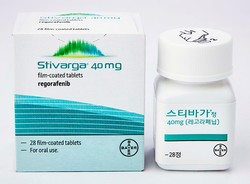Bayer’s Stivarga (ingredient: regorafenib), a second-line treatment for hepatocellular carcinoma (HCC), showed a 54 percent improvement in survival extension in real-world data of Asian patients, compared to the survival improvement shown in the previous clinical trial, a paper showed.
Professor Lim Ho-yeong of the Department of Hematology and Oncology at the Samsung Medical Center presented the interim results of the Asian sub-analysis on the REFINE study, a prospective real-world trial on Stivarga, at the European Society for Medical Oncology (ESMO) Virtual Congress 2020 on Saturday.

REFINE is an observational study that prospectively analyzed the effects of Stivarga as a secondary or higher treatment in 500 patients with unresectable HCC.
Lim disclosed the interim results of data from 182 Asian patients, including Koreans.
About 70 percent (127 people) of all Asian patients in the sub-analysis of REFINE were Koreans, 26 percent (48), Chinese, and 4 percent (7), Taiwanese. Fifty-four percent of the patients (99) had Eastern Cooperative Oncology Group (ECOG) scores standing between 1 and 4. Many of them had poor general health conditions compared to those with an ECOG score of 0. Patients with Grade B with moderate liver function were 5 percent (10) in Child-Pugh Score Class.
In the study, 92 percent of the Stivarga-treated patients previously received Nexavar (sorafenib).
The study results showed that the median overall survival (OS) of 182 patients was 16.3 months, a 52 percent increase compared to 10.6 months shown in the phase-3 RESORCE study, Lim said. The median OS was also longer than 13.2 months shown in the total cohort of the REFINE study.
Stivarga demonstrated stable safety profiles. Treatment-related adverse reactions with Grade 3 or higher occurred in 11 percent of the Asian patients, and Grade 4 or 5 serious adverse reactions did not happen.
Treatment-related adverse reactions with Grade 3 or higher included diarrhea (2 percent), limb syndrome (1 percent), hypertension (1 percent), and fatigue (1 percent), which were generally similar to the adverse reaction patterns seen in the previous RESORCE trial.
“The results are meaningful in that there was a significant improvement in the survival rate, although the study included many patients with moderate liver function and poor general health condition,” Lim said.
It would be more meaningful for domestic patients because the sub-analysis study on many Koreans reaffirmed survival improvement and safety profiles of the first-line Nexavar and second-line Stivarga treatment, he added.

